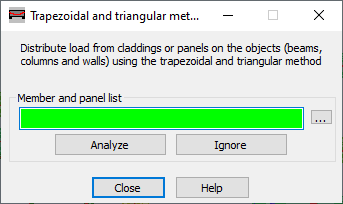Open the Cladding dialog using either of the following methods:
- Click Geometry menu > Additional Attributes > Load Distribution - Claddings.
- Click
 .
.
The option defines a Cladding, that is, a surface that lets you distribute planar, linear and concentrated loads on bars, panels and supports. This object can considerably facilitate generating loads; it allows you defining real structure objects that do not participate in the load capacity of a structure, such as panel walls and roofing. You can apply planar loads (uniform or not uniform, defined on any contour or object), linear (defined by 2 points or on edges) and concentrated (force at the point) to claddings. You can also use claddings when 3D snow and wind loads are generated. A finite element mesh is not generated on a cladding; it is an auxiliary object for defining loads.

The dialog has the following parts:
- At the top: Several icons
- The list field: Displays available cladding types
- At the bottom: The current selection field and standard buttons.
At the top of the dialog:
 ,
,  ,
,  , and
, and  - Displays the list of active cladding types as: large icons, small icons, short list, or long list
- Displays the list of active cladding types as: large icons, small icons, short list, or long list  - Opens the Label Manager dialog.
- Opens the Label Manager dialog.
The list field displays 3 available types of load distribution based on the load direction:
- Two-way - isotropic
- One-way X - anisotropic: parallel to the local x axis of a panel
- One-way Y - anisotropic: parallel to the local y axis of a panel and perpendicular to the local x axis of a panel.
A surface object is generated in the form of a face with defined cladding. A surface is defined in the same manner as a panel (by indicating an internal point or the list of linear objects).
You can also define a cladding by selecting the Geometry menu > Claddings.
Loads from claddings are distributed on all objects in the contour and plane of a cladding:
- Bars in the cladding plane - Robot automatically finds all bars in the plane and contour of a cladding; it generates a linear, trapezoidal load on a bar
- Nodes of supporting bars - a load is distributed on nodes that belong to bars adjoining the cladding plane (such as columns supporting the cladding) it generates a nodal load. Distribution to nodes is ignored for one-way distribution
- Support nodes - a load is distributed on nodes that are assigned supports, however, the necessary condition is that a support is assigned advanced column properties, that is, the support dimensions needs to be specified. A contour of dimensions of the support determines an area of a rectangle; the load is distributed on this rectangle using the trapezoidal and triangular distribution; it generates a nodal load.
- Edges of supporting panels - a load is distributed on edges of panels that are adjacent to the plane of a cladding (such as walls that support a cladding or slabs on which a load from the external panel wall is distributed); it generates a linear, trapezoidal load on the edge.
You can select objects that lie in the plane of a cladding (or of a panel for which the trapezoidal and triangular distribution is selected in a calculation model) and do not carry loads. In a real structure, these can be elements of roof bracing that do not carry the load transferred from the roofing. You can select objects using either of the following ways:
- use options in the Inspector pane - in the object properties (bar or panel); for the Trapezoidal and triangular distribution option you can select Analyze (an object carries loads) or Ignore (an object does not carry loads)
- use the Trapezoidal and triangular method options dialog by selecting the Loads menu > Special Loads > Trapezoidal and Triangular Method Options; objects from the bar and panel list:
- carry loads - after clicking Analyze
- do not carry loads - after clicking Ignore.
Click (...) to open the Selection dialog.

You can define a surface by assigning cladding to a face-type object for the following structure types: bar structures and shell structures. It is assumed that for volumetric structures the face object behaves like a face of a volumetric structure; you cannot define loaded surfaces on such an object. All types of loads (planar, linear, and nodal) can be applied to a cladding, except for 2 types of planar loads: hydrostatic pressure and thermal loads.